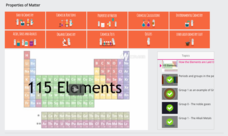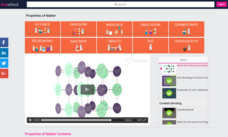Fuse School
Allotropes of Non-Metals
Graphite, charcoal, and diamond are all made of carbon, yet they have very different chemical properties. The video introduces allotropes, the different physical forms of the same element. It offers multiple examples and stresses the...
Fuse School
Mendeleev and the Periodic Table
Two hundred years before Mendeleev created the periodic table, scientists observed patterns in the elements and tried to sort them. The brief first video in a 15-part series explains the development of the periodic table and the many...
Fuse School
Giant Chemical Structures - Part 2
This lesson's gonna be huge! The fifth of a six-part series discusses the formidable lattices created by ionic compounds, as well as bonding in metallic elements. Chemistry scholars learn the properties of both types of substances and...
Crash Course
A Brief History of the Universe
No one was actually there to see the birth of the universe, but years of collaboration between physicists and mathematicians allow us to glimpse all but a fraction of a second of it. A narrated journey shows the phase changes early...
Curated OER
Phase Diagrams
In his previous videos, Sal shows students how to calculate how much energy is needed to change various amounts of water from state to state when the atmospheric pressure is constant. In this video, he shows students how to use phase...
Crash Course Kids
Chemical Changes
Your enthusiastic chemists will flip over this entertaining video about matter and its chemical changes! Take an in-depth look into what chemical changes are and the evidence that is observed, such as color, smell, and heat. Then,...
Crash Course Kids
(LEGO) Block Party
Get your blocks out! It's time to start building and learning about mass! Enthusiastic chemists get in-depth information about the conservation of mass and the way it applies to chemical changes.
Crash Course Kids
Oobleck and Non-Newtonian Fluids
Find out how matter fits into more than one state with this entertaining video that details non-newtonian fluids and a step-by-step instruction for how to make oobleck.
Project WET Foundation
The Incredible Journey
Go on an incredible journey called the water cycle with a video that details the ins and outs of water, its various forms, and place on planet Earth.
Bozeman Science
Matter
In 1924, Bose and Einstein predicted a fifth state of matter. The prediction proved to be true in 1995 and is referred to as the Bose-Einstein condensation. This video discusses the concept of matter, all five states of matter, and what...
Teacher's Pet
Phase Diagrams
This is one phase you'll enjoy going through with your class! Young chemists discover the components of phase diagrams in a video lesson. The narrator discusses temperature and pressure, then shows how their interaction affects the state...
Fuse School
Ionic Bonds
Isn't it ionic that when atoms steal from each other, we call it bonding? A brief video explains ionic bonds, details what an ion is, how they are attracted, and the type of bond formed. The first video in a six-part series on ionic...
Fuse School
Properties of Ionic Substances
Scholars learn about ionic substances, but how often do they encounter them in their daily lives? The final video in a six-part series explains ionic substances are more common that most people realize. The narrator discusses the...
Fuse School
How the Elements are Laid Out in the Periodic Table
When scientists confirm new elements, do these elements always fit in on the periodic table where scientists expect? The second video in a series of 15 discusses how the elements are organized on the periodic table. The resource includes...
Fuse School
Group 2 - Alkaline Earth metals
Alkaline earth metals each burn with a different-colored flame. The seventh video in a 15-part series focuses on the alkaline earth metals in group two. It discusses their properties and how they vary based on periods, explains the...
Fuse School
Solubility Curves
How do chemists use solubility data? Chemistry scholars learn the usefulness of solubility curves and how they are generated. The seventh part in a series of 14 discusses the solubility rules, plotting solubility data, and how pupils can...
Fuse School
Element, Mixture or Compound
Don't get mixed up about the differences between elements, mixtures, and compounds! Part one of a six-part series discussing these important classifications of substances illustrates simple tests one can perform to determine a material's...
Fuse School
Group 1 - The Alkali Metals
People use alkali metals, such as lithium, for many commercial purposes. The sixth video in a 15-part series covers the alkali metals. It explains the properties they share, how to handle them safely, and how the rate of reactions change...
Fuse School
Group 7 -The Halogens
The eighth video in a 15-part series focuses on the halogen group on the periodic table. It covers the valence electrons, the common reactions, and the uses for these elements. It also offers ideas for experiments to show reactivity.
Fuse School
Reactions of Halogens
Did you know that a halogen reaction actually creates household bleach? The ninth video in a 15-part series limits itself to the reactions of halogen elements. It uses multiple examples of the unusual reactions from this group including...
Fuse School
Properties of Hydrogen
Hydrogen is the most abundant element in the universe. The 12th video in a 15-part series on the periodic table of elements focuses on hydrogen. It describes its role in the universe, how it appears in nature, how we use it in...
Fuse School
Properties of Oxygen
Oxygen makes up 21 percent of Earth's atmosphere. The 13th video in a series of 15 discusses the properties of oxygen. It highlights the importance of it for respiration and corrosives. It goes on to mention the down sides of oxygen such...
Fuse School
Properties of Nitrogen
Manufacturers package foods using nitrogen to help preserve freshness and prevent bacteria from growing. The 14th video in a 15-part series discusses the properties of nitrogen. It has many uses in industry, research, and health, and the...
Fuse School
Giant Ionic Structures/Lattices
Ionic compounds don't exist as individuals; they only exist as a small part of an ionic lattice. The fourth video in a series of six discusses how the lattices form. It explains the attraction of ions and the common properties of these...

























